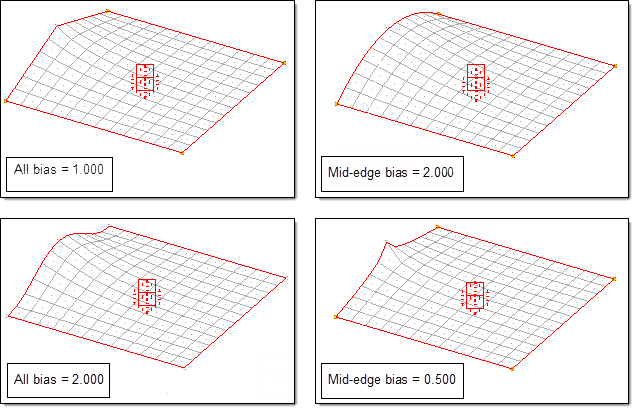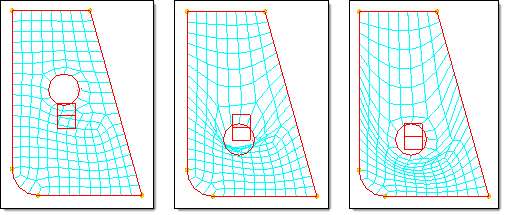Using Biasing |

|

|

|

|
|
Using Biasing |

|

|

|

|
Biasing allows you to control the shape of a mesh when applying handle perturbations. Biasing increases or decreases the influence of a handle over the nodes within its area of influence. If the biasing values for all of the handles are equal to 1.000, which is the default value for all handles except for dependent handles on 1D domains, the morphing between the handles is linear, provided both handles are global handles or they are located on edge domains. Higher biasing values generate a smooth curvature near the handles, while lower biasing values generate harsh corners near the handles. To smoothly change the shape of a domain it is recommended that you use a biasing factor of 1.000 at the corners, 2.000 at the edges, and 3.000 in the middle.

Biasing for a 2D domain
The model at the upper left has all five handles with the default biasing value of 1.000. The model at
the upper right shows the four corner handles with a biasing value of 1.000, and the mid-edge handle
with a biasing value of 2.000. The model at the lower left has all five handles with the default biasing
value of 2.000. The model at the upper right shows the four corner handles with a biasing value of
1.000 and the mid-edge handle with a biasing value of 0.500.

Biasing to reduce mesh distortion
When the hole is moved downward with a biasing factor of 1.000 for the handle at the hole,
the mesh folds over due to the influences of the other handles (middle frame). When the
biasing value of the handle at the hole is increased to 3.000, the mesh unfolds (right frame).
Biasing can be applied retroactively after a morphing operation. After applying a morph, you can change the biasing value by activating the make retroactive check box, and have the current list of applied morphs updated to reflect the new biasing values. This is useful in selecting a good biasing value to apply for a given morph. Apply the morphs and change the biasing values retroactively until you get the shape that you want.
See Also: